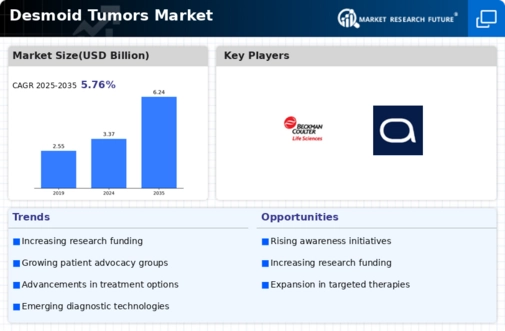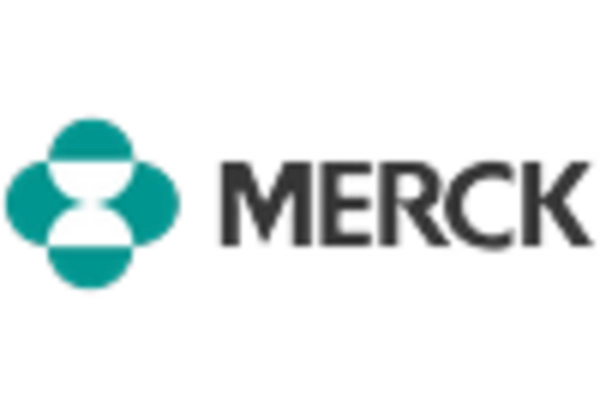Increased Awareness and Education
The growing awareness and education surrounding desmoid tumors significantly influence The Global Desmoid Tumors Industry. Educational initiatives aimed at both healthcare providers and patients are essential for improving diagnosis and treatment outcomes. As more information becomes available regarding the nature of desmoid tumors, their symptoms, and potential treatment options, patients are more likely to seek medical advice promptly. This proactive approach can lead to earlier interventions, which are crucial for effective management. Additionally, patient advocacy groups play a vital role in disseminating information and supporting research efforts. Their activities contribute to a more informed public, which may lead to increased demand for specialized care and therapies. Consequently, this heightened awareness is expected to foster growth within The Global Desmoid Tumors Industry, as healthcare systems adapt to meet the needs of an informed patient population.
Rising Incidence of Desmoid Tumors
The increasing incidence of desmoid tumors is a notable driver for The Global Desmoid Tumors Industry. Recent data indicates that the annual incidence rate of desmoid tumors ranges from 2 to 4 per million people, suggesting a growing patient population. This rise in cases necessitates enhanced treatment options and healthcare resources, thereby stimulating market growth. As awareness of these tumors increases among healthcare professionals and patients, early diagnosis and intervention become more prevalent. Consequently, this trend is likely to lead to a higher demand for specialized therapies and management strategies, further propelling The Global Desmoid Tumors Industry. The need for effective treatment modalities is underscored by the complexity of desmoid tumors, which can be challenging to manage, thus creating opportunities for pharmaceutical companies to innovate and expand their product offerings.
Advancements in Treatment Modalities
Innovations in treatment modalities represent a critical driver for The Global Desmoid Tumors Industry. Recent advancements in targeted therapies and surgical techniques have shown promise in managing desmoid tumors more effectively. For instance, the development of novel pharmacological agents, such as tyrosine kinase inhibitors, has demonstrated efficacy in reducing tumor size and improving patient outcomes. The market is witnessing a shift towards personalized medicine, where treatments are tailored to individual patient profiles, enhancing therapeutic effectiveness. Furthermore, clinical trials are increasingly focusing on these innovative approaches, with several studies currently underway to evaluate new treatment options. This focus on research and development is likely to attract investment and drive growth within The Global Desmoid Tumors Industry, as stakeholders seek to capitalize on emerging therapies that address unmet medical needs.
Growing Investment in Oncology Research
The surge in investment directed towards oncology research is a pivotal driver for The Global Desmoid Tumors Industry. Governments and private entities are increasingly recognizing the need for research focused on rare tumors, including desmoid tumors. This influx of funding is facilitating the exploration of novel treatment options and the development of clinical trials aimed at understanding the biology of these tumors. As research progresses, it is anticipated that new therapeutic agents will emerge, enhancing the treatment landscape for patients. Moreover, collaborations between academic institutions and pharmaceutical companies are likely to accelerate the pace of innovation. This collaborative environment fosters a robust research ecosystem, which is essential for advancing The Global Desmoid Tumors Industry. The potential for breakthroughs in treatment options could significantly impact patient outcomes and market dynamics.
Regulatory Support for Rare Disease Treatments
Regulatory support for treatments targeting rare diseases, including desmoid tumors, serves as a crucial driver for The Global Desmoid Tumors Industry. Regulatory agencies are increasingly implementing policies that facilitate the development and approval of therapies for rare conditions. This support includes expedited review processes and incentives for pharmaceutical companies to invest in research and development. As a result, there is a growing pipeline of potential treatments aimed at desmoid tumors, which could lead to increased market activity. The favorable regulatory environment encourages innovation and attracts investment, as companies seek to bring new therapies to market. This trend is likely to enhance the availability of effective treatment options for patients, thereby driving growth within The Global Desmoid Tumors Industry. The alignment of regulatory frameworks with market needs is essential for fostering a sustainable and dynamic industry.

















Leave a Comment